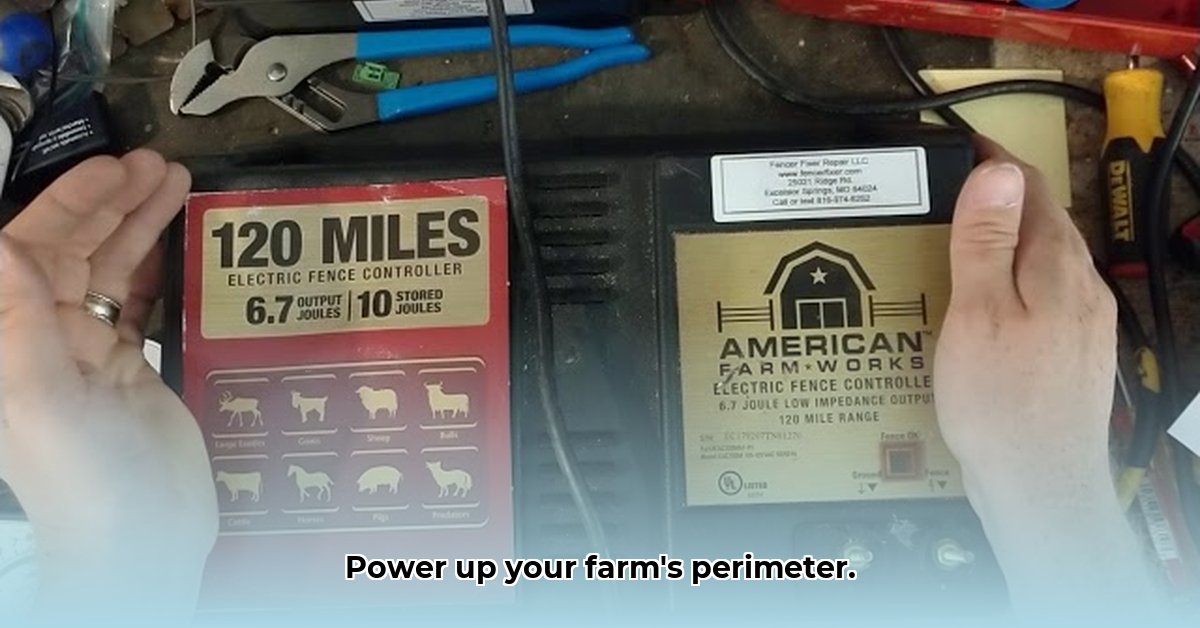
Electric fencing offers a humane and effective way to manage livestock, contributing to sustainable farming practices. Choosing the right fence charger, however, requires careful consideration. This guide helps you navigate the options available at Tractor Supply, ensuring you select the best energizer for your specific farm needs. For additional livestock management resources, check out these helpful resources.
Understanding Your Options: Solar vs. AC-Powered Fence Chargers
Tractor Supply typically stocks two primary types of fence chargers: solar and AC-powered. Each has distinct advantages and disadvantages.
Solar-Powered Fence Chargers: These eco-friendly options utilize solar energy, making them ideal for remote locations or farmers prioritizing sustainability.
- Pros: Environmentally friendly, suitable for remote areas, lower long-term operating costs (primarily battery replacements).
- Cons: Performance depends on sunlight availability, generally less powerful than AC chargers, requires periodic battery maintenance.
AC-Powered Fence Chargers: These chargers offer consistent, reliable power, making them suitable for larger farms and more demanding livestock.
- Pros: Consistent power output, typically more powerful, simpler installation.
- Cons: Requires a nearby power source, higher operating costs due to electricity consumption, unsuitable for remote locations.
Cost Analysis: A Comprehensive Comparison
The initial cost is only one factor. Let's analyze the total cost of ownership, considering initial investment, operational expenses, and potential long-term savings. Note that prices at Tractor Supply fluctuate; always verify current pricing.
| Feature | Solar-Powered (Estimated) | AC-Powered (Estimated) |
|---|---|---|
| Initial Cost | $150 - $300+ | $100 - $250+ |
| Annual Operating Cost | $20 - $50 (Battery replacement every 3-5 years) | $10 - $50+ (Electricity cost, varies by usage and location) |
| Long-Term Savings Potential | Reduced labor costs, improved pasture management | Reduced labor costs, improved pasture management |
Important Note: These are estimates. Actual costs depend on usage, local electricity rates, battery lifespan, and specific charger models. A detailed cost-benefit analysis considering your farm's unique context is essential. Have you considered the potential long-term savings from reduced labor associated with improved pasture management?
Key Factors Influencing Your Choice
Several factors beyond charger type significantly impact your decision:
- Farm Size: Larger farms generally need more powerful chargers to maintain sufficient voltage across extensive fencing.
- Livestock Type: Stronger or more determined animals require a more potent energizer to prevent escapes.
- Terrain: Hilly or uneven terrain can affect voltage consistency, potentially necessitating a higher-output charger.
- Climate: Solar chargers rely on sunlight; cloudy regions might require supplemental power or an AC alternative.
- Fence Length: Longer fences require chargers with a greater output capacity.
Tractor Supply's Offerings: A Closer Look
Tractor Supply offers a range of chargers from various brands, including American Farm Works and others. However, availability and specific models change, so check their website or a local store for the most current information. Online reviews from other farmers can provide valuable insights into product performance and reliability. Always verify specifications before purchasing.
Installation and Maintenance: A Practical Guide
Proper installation and maintenance are crucial for fence effectiveness and safety.
Installation:
- Grounding: Use multiple ground rods driven deep into the earth to ensure optimal conductivity. (A poorly grounded fence is ineffective and dangerous.)
- Wiring: Employ dedicated electric fence wire and ensure all connections are secure and corrosion-free.
- Testing: Use a fence tester to verify adequate voltage after installation.
Maintenance:
- Regular Inspection: Inspect wiring for damage, loose connections, or broken insulators at least monthly.
- Terminal Cleaning: Maintain clean terminals to prevent corrosion and ensure optimal conductivity.
- Voltage Checks: Regularly test fence voltage to guarantee sufficient power.
Safety Precautions: Prioritizing Safety
Electric fences pose a risk of electric shock. Always:
- Disconnect Power: Turn off the charger before maintenance or repairs.
- Insulated Tools: Use insulated tools to prevent accidental shocks.
- Wet Conditions: Avoid touching the fence in wet conditions, as water increases conductivity.
Conclusion: Making an Informed Decision
Selecting the right fence charger depends on your unique farm context. Consider farm size, livestock type, terrain, climate, and budget. Weigh the initial cost against long-term operational expenses and potential savings. Utilize resources such as Tractor Supply's website, online reviews, and the expertise of their staff to make an informed decision that optimizes your farm's efficiency and sustainability.
Further Reading and Resources
For additional resources on electric fencing, consult your local agricultural extension service or refer to publications from the United States Department of Agriculture (USDA).